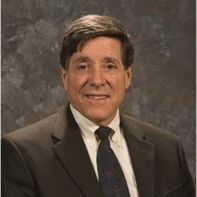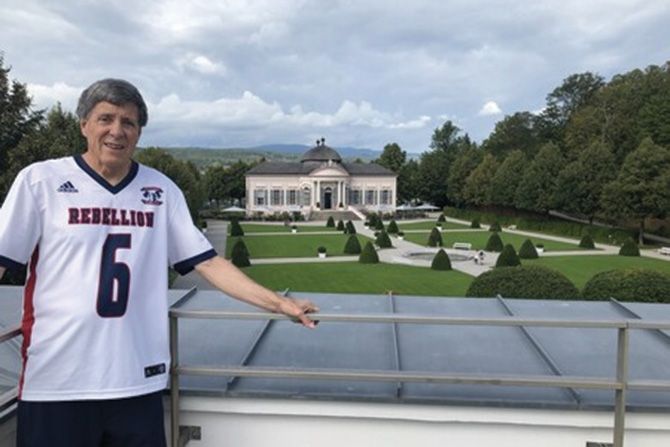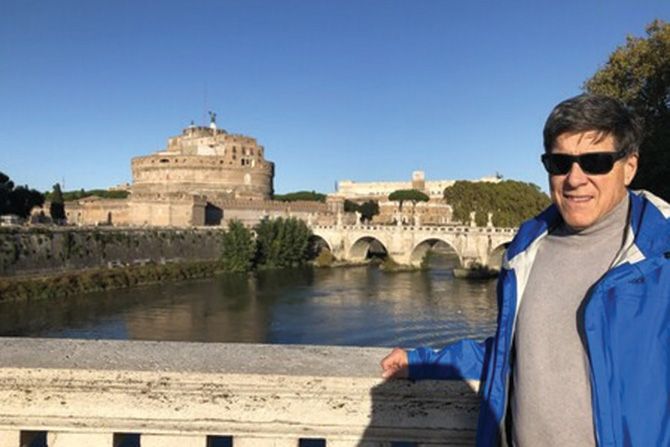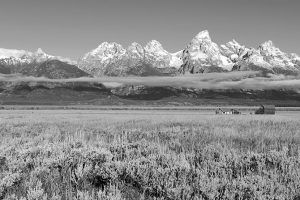
Jim Rose, AIA, retired in 2018. He spent most of his career as an architect and teaching architectural engineering. Jim also worked as a historic preservation consultant.
AIA Wyoming recently interviewed Jim about his career and life.
Where are you from originally?
I grew up in Lingle, Wyoming. It’s located in the southeastern part of the state and was named after my great uncle, Hyram Lingle, a civil engineer who worked on the first irrigation project before Wyoming became a state in 1890 and before the turn of the 20th century. He worked on two canals that branched off the North Platte river and wend their way into Nebraska.
Please tell us about your education.
My high school graduating class had 32 people. That was the largest class they had until the school consolidated. I spent a year at the local community college. It didn’t have the pre-engineering classes I needed, so I went to the University of Wyoming during my sophomore year because it was the only four-year institution in Wyoming.
At that point, I hadn’t thought much about what kind of engineering to study. I thought I might be interested in aeronautical engineering, but I wanted to take as many building-related classes as possible by the time I got to the University of Wyoming. They only offered architectural engineering, so I changed to that and graduated in 1971.
The following fall, I went to graduate school at the University of Virginia in Charlottesville. I graduated from UVA in 1973 with a master’s degree and was an intern architect in Fort Collins, where I live now.
Please tell us about your family (past and present).
My mother was never employed outside the home after having a family. During World War II, she worked in the manufacturing industry in Detroit, Michigan, doing armaments. My father was a blacksmith. He was in the Navy during World War II and formed a company with his brother in the farm equipment business. That’s the job and company he had until he retired. My younger brother still has my father’s business. My younger sister is a retired elementary teacher.
My wife, Michele, is a retired teacher, and we have three children. Our oldest daughter is a clinical social worker and counselor at the elementary school level who also does online private counseling. She and her husband have two sons. My middle child is a physician and pediatrician; he and his wife have two daughters. Our third child is a National Oceanic and Atmospheric Administration research ship commander.
When and why did you decide to become an architect?
When I started my university education, I liked physics and those kinds of things, and I was intrigued by the general idea of engineering. Some campus building projects were going on while I was an undergrad, and I was interested in how buildings came together during construction.
Architectural engineering was an option program that was a subset of civil engineering. That was as close as I could come to studying architecture. I was invited to join the Peace Corps after graduation, go to Micronesia and help with building development, but I didn’t want to leave my wife at home. I realized I was interested in architecture and didn’t want to practice as an engineer. I applied to graduate school instead and was accepted at UVA.
You’ve had your license since 1976 and have been a member of AIA Wyoming for almost 50 years. Why is it important to be a member of AIA Wyoming?
My first job out of grad school was in Fort Collins, but after a fairly short tenure there, I took a job and completed my internship in Lander, Wyoming. I joined AIA Wyoming as an intern in Lander.
Being a member of AIA Wyoming is very important initially when you are in practice. It gives you a chance to sustain contact with colleagues and stay informed, and there are educational opportunities, too, so you can hone your professional skills. You can maintain contact and fluency with what’s happening in the profession. As part of the national organization, you could also participate vicariously on the national level and develop a national profile. Those were the original motives for being involved.
I am still a member because I have friends and colleagues in the association, and I enjoy continuing my education. Most of my colleagues are retiring or have retired, but I am always intrigued to see what other architects are doing and how the profession is changing.
Please tell us about your years in private practice before you began working in academia.
I was licensed in 1976. I established a sole proprietorship with one draftsman, and my wife helped me with books and billing. As a sole proprietor, I started with remodels and residential work. After a year, I had more work than I could manage, so I took a partner, and we formed a practice. That evolved into more commercial and institutional projects, such as schools, a major jail and other commercial work. We had a significant amount of work, and the practice grew to eight people. We did the kinds of projects a small firm would do. Lander being what it is, we worked all over the state, which was a challenge with a small family. I enjoyed it, but when you are a principal in a small firm, it’s not a 40-hour work week, and there is a lot of time on the road and away from home. I was enjoying it, but it created some hardships.
When did you decide to become a professor?
I was offered a university position. My wife thought that was a great opportunity because she hadn’t finished her degree as an elementary music teacher, and she wanted to. It was also a chance to slow things down, and I thought it was worth testing out what it would be like to be an academic. I sold my part of the practice and became an assistant professor at the University of Wyoming. I meant to go for two years and then go back into practice, but I enjoyed teaching. The environment in the late 1970s and early 1980s had changed enough that I kept my license but did not jump back into practice.
I spent 18 years moving up the ranks, earned a doctorate and then went into administration and the community college system. My doctorate focused on community colleges. I was in a cohort program where most of the work was during the summer. I became a dean at Santa Rosa Junior College in California. I was an administrator for five years. We were comfortable in California, but our family was in Wyoming, and my wife said, “Let’s go back.” That was 2005. I directed the community college system in Wyoming as a cabinet-level administrator until I retired from that work in 2018. Then we moved back to Fort Collins after being away for 50 years.
Please tell us about your time teaching at the University of Wyoming and Loyola University of Chicago, Rome Center.
The courses I taught at the University of Wyoming covered the spectrum of architectural engineering, engineering sciences, specifications, estimating and traditional engineering. I spent 10 years as a full professor. My focus as an architect was on designing passive solar residences.
My first sabbatical, and my first one abroad, was in 1990. I received a fellowship from a foundation that supported my application to be a 1990 ICCROM delegate from the U.S. for six months. ICCROM is the International Centre for the Study of the Preservation and Restoration of Cultural Property, and its headquarters are in Rome. It is part of UNESCO, although that isn’t reflected in the title. The program had delegates from 23 countries. Although I had done a historic structures assessment on a territorial penitentiary, my work at ICCROM really gave me a stimulus to do more. I became fully involved in all aspects of preservation and started doing preservation work in earnest.
For my second sabbatical, I taught a one-semester survey course in architectural history about the Italian Renaissance at the Loyola University of Chicago, Rome Center. While there, I sometimes consulted with a colleague at the University of Rome. We discussed historic preservation and his then-ongoing work at the Domus Aurea in Rome.
After returning to the U.S., I worked with a colleague in American Studies to start a master’s program in historic preservation, did a lot of consulting work in preservation, and taught graduate courses about preservation, architectural history and other subjects.
What was it like to be a professor? What were your most important accomplishments?
My most significant accomplishments were the chances to meet former students and see how their successes have played out. I had a little bit to do with that. I created some opportunities, helped them find positions, helped them through some courses, and told some students, “You aren’t meant to be an engineer; you should be an architect.” Some of them took my advice and became architects.
When I came to the University of Wyoming in 1982, our program was an option in engineering. I worked hard for several years with the national society of architectural engineers, the architectural engineering group and the accreditation board for engineering and technology to get our program independently accredited as a pure program in architectural engineering instead of a subset program. I had to do a lot of work writing the curriculum for review and approval. As a result, students could take courses in the area that would benefit them instead of taking unnecessary ancillary courses.
You can’t be a generalist. As an architectural engineer, you must be fluent in the building’s systems. That is easily a four-year program because buildings are extraordinarily complex. Being a design professional with the expertise to design those systems requires a lot of specialized coursework. As the program grew, it became one of the largest programs in engineering. Students can now study structural systems, electrical systems, HVAC, fire suppression and communications.
If you were mentoring a young architect, what advice would you give them?
I am not an expert in the long-term progression of being a design professional. My predominant role was as an academic. That said, here is my advice:
- Listen for guidance and ideas from wherever it comes, no matter the source. You can learn from practitioners and people who have been at it a while or people outside the profession. Don’t think you are the sole source of wisdom when working on something as complicated as a building.
- Don’t feel frozen in a position. Explore your passion. Some ideas come to pass, and some don’t, but don’t put anything out of your head that you would like to do, even if you are not sure you can pull it off.
How did you get involved in historic preservation?
I was always interested in architectural history and almost majored in it at the University of Virginia, but I thought my job options might be limited if I did. I chose to complete a traditional master of architecture degree instead.
My master’s degree coursework allowed me to take a one-semester studio course from a Venetian architect. He taught us about the preservation of buildings. It was stimulating. I also took other graduate courses, such as urban history, that followed and developed my interests.
When I served as an intern and had my practice, I did some traditional preservation, but it was not the bulk of my work. I became intrigued with projects as I taught history and had opportunities to do consulting. That brought opportunities to study historic preservation in more depth. After my experience with ICCROM, I got more involved in things like historic preservation, commissions and committees, state agencies and cultural resource preservation. I am currently the VP co-chair for the Fort Collins historic preservation commission, which works to save old buildings.
How has architecture changed during the decades you’ve been a part of the profession?
Moving from slide rules to personal computers with architectural computer graphics is the biggest change. During the early 1970s, you were still calculating the same way they did at the turn of the century, and hand-held calculators were a novelty. I used a slide rule when I began as an engineering student. You had to approximate the order of magnitude and understand whether the numbers made sense.
Now there are no hard-copy drawings anymore. People work on iPads and laptops to make real-time corrections. It’s a vast improvement, but some students aren’t adept at sketching an idea if they don’t have a computer. Also, sometimes students don’t realize the order of magnitude is wrong when they read the answer from a TI calculator. They might not realize that $43,000 per square foot makes no sense.
On the other hand, computers made the profession more effective. Better coordination of overlapping systems means you can prevent conflicts early. For example, the plans might have a beam where you need to run a conduit, and you can see the problem early enough to change it before it becomes more expensive and difficult.
What are your favorite accomplishments? They could be buildings you’ve designed or something you’ve done as a professor.
My biggest accomplishment is being married for 52 years and raising a family of three successful young people with my wife.
My other big accomplishment was making a difference to at least one other student during their college experience. I hope I gave students the help, encouragement and confidence they needed. Students could be stimulating, challenging, and sometimes frustrating, but you could see their progress. The real reward of teaching is when a student still knows who you are and what you were able to do together five years after they graduate and are in active practice. Honors, awards and accolades are beside the point.
What is your most important legacy as an architect?
It’s indirect. The work we did to create a program in architectural engineering prepares qualified professionals to do work in architecture, not just engineering. I wouldn’t have accomplished that without my education and architectural experience. We helped students understand the difference between being an architect and an architectural engineer. We taught them communication and the full realm of what is involved in designing and creating a building.
Things don’t get done in isolation anymore. You have to be a team and understand something about your other team members. One of the benefits of moving from an option program to an independent accredited program was the focus on how the whole profession could be integrated between the two professions (engineer and architect) as they communicate across the disciplinary lines. Everyone should be a player on the same team.
I was comfortable as an architect. I jumped from that to being a professor, even though I still had my hand in some form of architectural practice. As I became involved in educational pedagogy, I became more fascinated with the community college. Students who came to me were pretty well prepared in high school, but they were not prepared for engineering. So many students were capable but didn’t have the opportunities because of a lack of attention or opportunity. They had to choose other paths.
I am grateful I was never frozen into a position. I could look beyond and say, “Maybe there is something else to do.”
What are you doing now?
I’m involved in historic preservation here in Fort Collins. My wife and I also sing in a chorale of 80-100+ people. It’s an interesting group to be involved in. We travel some, too. We recently returned from three weeks in Europe and enjoyed doing that. We also spend some time with our family when opportunities arise.









